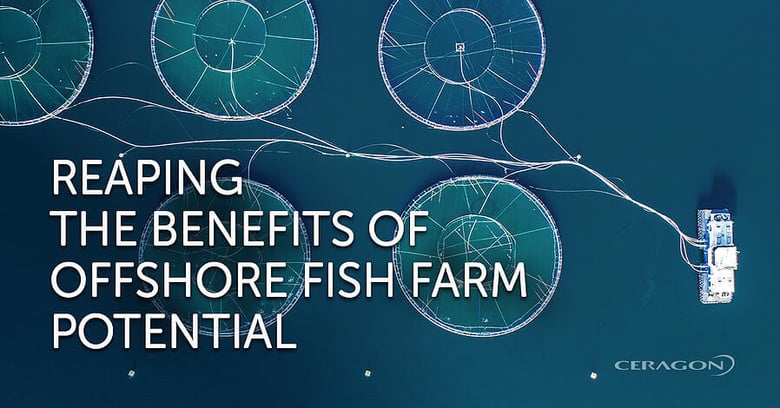A wide range of automated monitoring devices, smart feeding systems, remotely operated underwater vehicles, and smart camera systems are making inroads in marine aquaculture, generating petabytes of data each day. Monitoring, sensing, and sending all this data, along with real-time visual, voice, and data communications, to a land-based control office requires a high-bandwidth, low-latency network. Learn how offshore fish farms can extend their service reach and quality by enjoying 24/7 high-throughput and uninterrupted stabilized connections. |
The global fish market is booming, with about 53% of the world’s fish production expected to originate from inland and marine aquaculture by 2030. Some 40% of total aquaculture production comes from offshore marine fish farms that operate in strong currents, severe storms, and high winds and waves. To meet the growing world population demand for sustainable protein sources, maintain high-quality standards mandated by the sector, and stay profitable, many marine aquaculture companies are entering a new era by adopting smart technology.
Fish farmers will undoubtedly improve their production cycle planning with greater adoption of automated monitoring devices, smart feeding systems, remotely operated underwater vehicles, machine learning, and artificial intelligence combined with smart camera systems. And round-the-clock monitoring of myriad data – fish health, size and weight, feeding irregularities, water temperature, dissolved oxygen levels, salinity, barometric pressure, wind, and current strength – will offer unprecedented insights into modern fish farm operations.
A high-bandwidth, low-latency network is required to monitor and send all of this data to a land-based control office via real-time visual, voice, and data communications. Such a network will enable offshore fish farms to:
- Cut costs by automating routine operations and accelerate decision-making
- Reduce feeding costs, which account for 60%-90% of total production costs, by releasing the optimal amount of feed and avoiding overfeeding or underfeeding.
- Minimize environmental impact and reduce waste caused by overfeeding
- Maximize efficiency
- Predict future conditions and take preventive steps
- Shorten the fish grow-out cycle
There is no question of wireless technology’s benefits and positive impact on marine aquaculture. Everything related to fish production is online. Therefore, relying entirely on communication technology, especially if open-ocean pens and barges are located at the edge or beyond the reach of commercial 4G/LTE networks, is a MUST.
Ceragon’s PointLink Access solution for offshore connectivity can carry a range of radio units – from point-to-point (PtP) microwave systems, through point-to-multipoint (PtMP) systems, to LTE backhaul. Designed with a technology-agnostic approach, PointLink Access provides high-throughput communications within 40km-70km of onshore base stations. By leveraging the solution’s stabilized antenna and benefiting from its agnostic radio feature enabling high-capacity radios and antennas, offshore fish farms can:
- Provide higher capacity and more reliable coverage compared to an omni or fixed antenna solution, enabling the infrastructure to deliver up to 8 times more capacity versus non-stabilized, limited omni antenna solutions
- Offer reliable connectivity and performance by eliminating interference. The stabilized nature of LTE/4G /Wi-Fi/MW antennas, with the base station as the focal point, ensures that interference arriving from various directions (e.g., other network users, signals, and even onshore) has little to no impact on the intended service experience of offshore sites.
- Maintain communications regardless of movement/motion (e.g., location, heave, yaw, pitch, roll), and ensure that service is not affected by environmental factors.
- Avoid costly, often submarine, fiber deployments, and terrestrial network changes.
By teaming up with Ceragon, offshore fish farms enjoy secure, reliable, and high-capacity communications at a far more favorable cost-per-bit. As such, fish farmers who embrace offshore broadband can optimize processes, accelerate decision-making, and become more efficient.
Download the PointLink Platform brochure for aquaculture communications to learn more:


